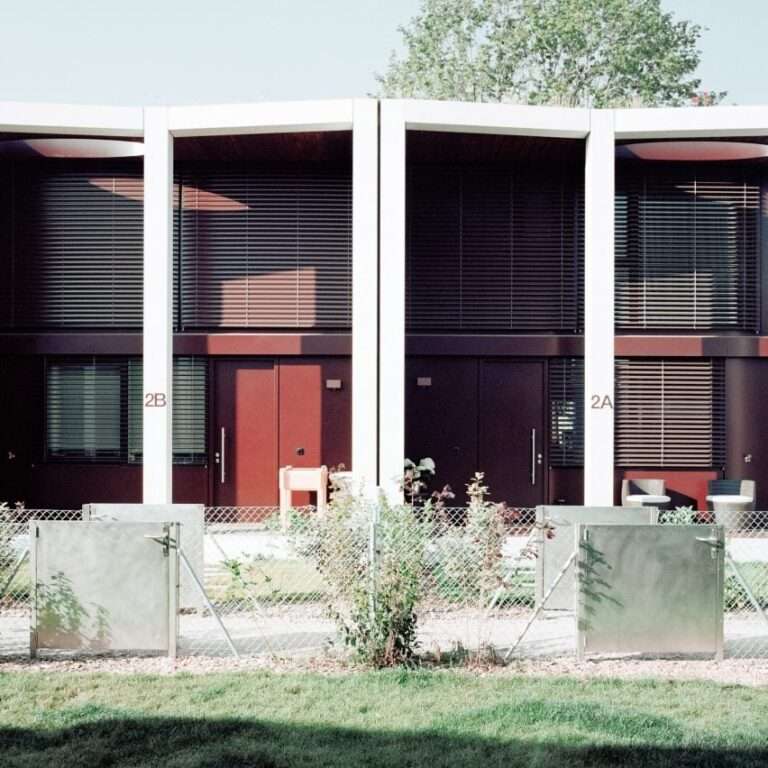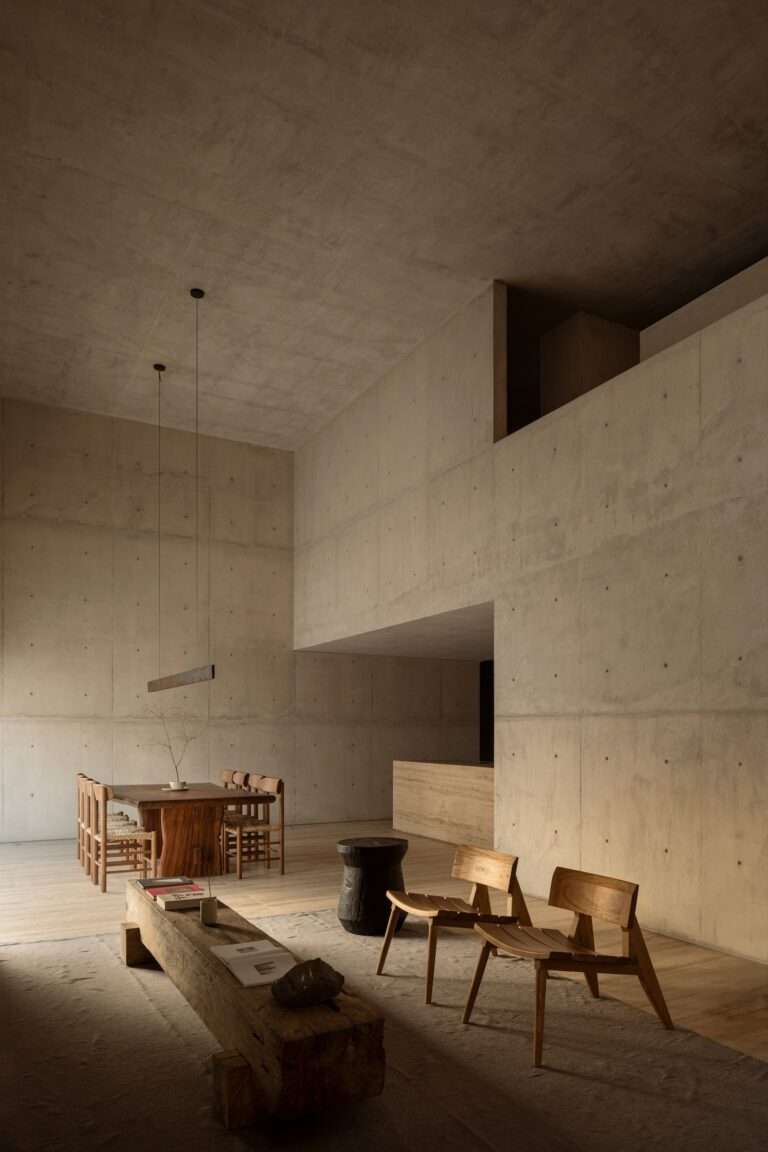Architecture for Changing Contexts: prototype’s Mobile Pavilion Envisions a Blueprint for Ukraine
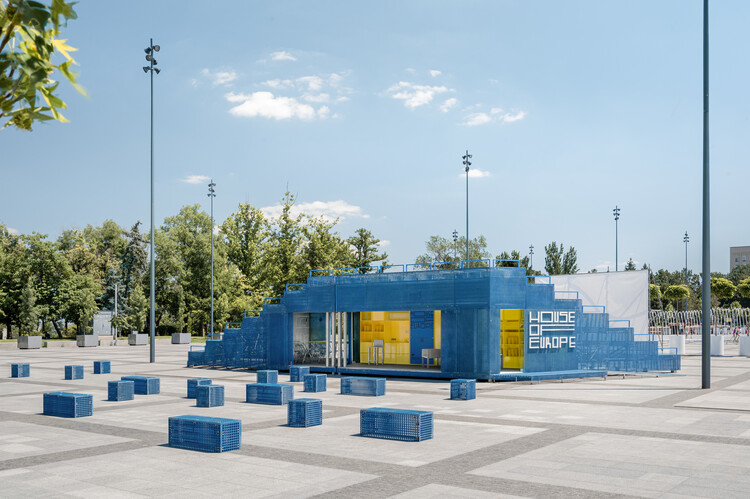
Amidst the current wave of architectural globalization, the art of crafting designs attuned to specific contexts is fading. This concern is especially significant in countries in crisis, such as Ukraine, where the built environment’s history is being eroded by war. In these conditions, the contribution of local architects with an innate grasp of the country’s cultural nuances becomes imperative. Leading the charge in the rebuilding of Ukraine is prototype, a pioneering practice that challenges architectural conventions to push the country towards a promising future.
Recognizing their forward-looking vision, ArchDaily has featured prototype as part of the 2023 New Practices, a global annual survey. prototype’s outlook on the future of architecture aligns with responsible design that addresses the environmental impact of construction and marries contextual and specific considerations for each project. Their recent accomplishments include the bookstore Readellion, and Ukrainian-Danish Youth House, epitomizing prototype’s recurring design principles of mobility, adaptability, dynamic levels, and change of scenarios.
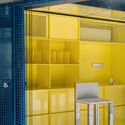

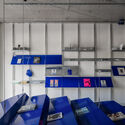
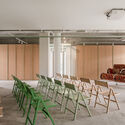

 Readellion / prototype . Image © Yevhenii Avramenko
Readellion / prototype . Image © Yevhenii AvramenkoEstablished in 2020, the Kyvian Architecture Bureau prototype has garnered attention for its visionary design processes and philosophies. Their conceptual approach is rooted in experimentation and thrives on the discovery of productive counterpoints through meticulous consideration of the site context. From residences to industrial infrastructure, their diverse portfolio showcases a commitment to detail, fabrication, and customization.
Related Article
Radical Rituals: Studio forty five degrees Searches for Local Space-Making Practices Across Europe
A notable testament to the bureau’s context-driven approach is the Mobile Pavilion, a project designed for the House of Europe initiative in Ukraine. Microrationality, prototype’s driving concept, manifests as the humanization of public spaces and its ability to adapt to Ukraine’s diverse landscapes. The House of Europe’s design competition aimed to foster cultural integration between the European Union and Ukraine, prompting the creation of a portable pavilion that travels across the country for cultural events. The winning design by architects Ivan Protasov of prototype, Yana Buchatska, Dmytro Mikheyev, Taras Baran, and Olha Kuchmagra successfully redefines public spaces across Ukraine. Challenging conventional architecture in Ukraine, the modular blue pavilion becomes a vibrant cultural hub, drawing citizens to participate in festivals, lectures, and workshops.
 House of Europe Mobile Pavilion / Ivan Protasov, Yana Buchatska, Dmytro Mikheyev, Taras Baran, Olha Kuchmagra. Image © Yevhenii Avramenko
House of Europe Mobile Pavilion / Ivan Protasov, Yana Buchatska, Dmytro Mikheyev, Taras Baran, Olha Kuchmagra. Image © Yevhenii Avramenko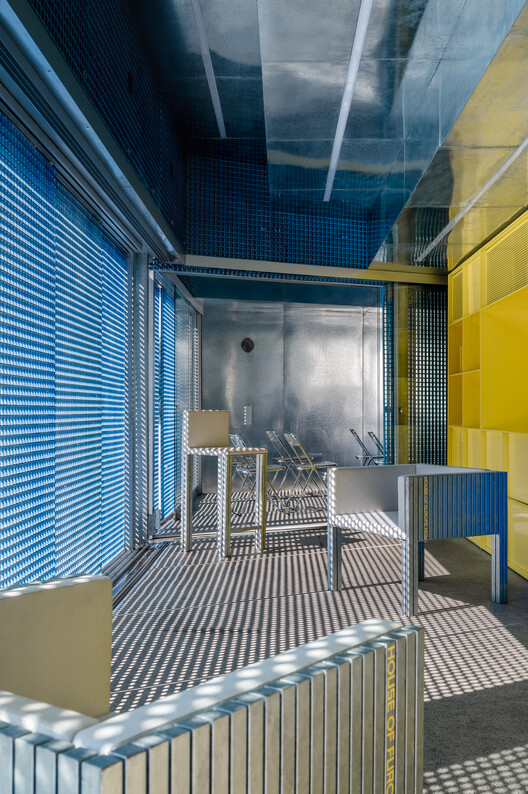
Ukraine’s architectural landscape presents a duality of compact European neighborhoods and Soviet-influenced widely spaced layouts. The Mobile Pavilion’s adaptability is a response to these contrasting contexts, designed to operate as a system that adapts to the scale of various public spaces. Research on design limitations, such as the average area of public squares and bridge heights in the country, was conducted to arrive at the final design. “We first approached the competition brief by thinking about creating an artificial landscape that works with its surrounding context”, Protasov reveals. The Mobile Pavilion now resembles a playground that can configure itself to changing contexts, taking on a new form in every city to offer users a fresh experience.
Essential to the design was modularity, allowing for effortless disassembly and transportation across different cities. The system is a combination of four structural elements – two containers for gatherings and an information hub, crowned with twin open-air auditoriums that seamlessly flow into the site. As the pavilion ventures through different urban landscapes, it adapts into six diverse configurations while offering distinctive workshops, film screenings, and concerts tailored to each city. With a footprint of 180 square meters, the architectural system not only crafts a one-of-a-kind public space but also evokes a sense of connectivity through its form, multilevel layout, and comprehensive 360-degree orientation.
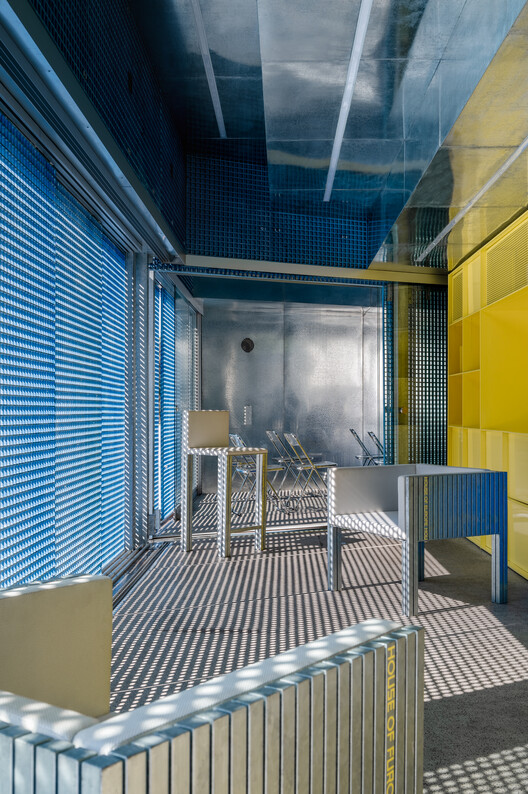
The project’s design philosophy also finds expression in its materials. A bright blue industrial FRP grating, encased in glass for soundproofing and thermal insulation, creates a visually permeable boundary between the interior and exterior. Symbolic of EU-Ukraine relations, this transparency mirrors the vulnerability and connectivity prototype seeks to foster in Ukraine’s public squares. The design not only visualizes openness but also transforms public spaces into inviting meeting points. Additionally, blue metal tubes form custom furniture, further bridging the gap between design and function.
Embodying prototype’s ethos of user-driven experiences, the pavilion serves as an “unconditional space” that invites active participation, enabling users to define the spatial configuration. The modularity allows users to exercise the freedom of defining the spatial configuration of the pavilion, thus appearing as an unfinished project. The pavilion’s unconventionality captured the attention of both young and old generations who began to have their dialogue with the system. “Architects are always striving to make things better, however, when you put that responsibility in the hands of the users, it results in democratic and adaptable spaces”, shares Mikheyev.
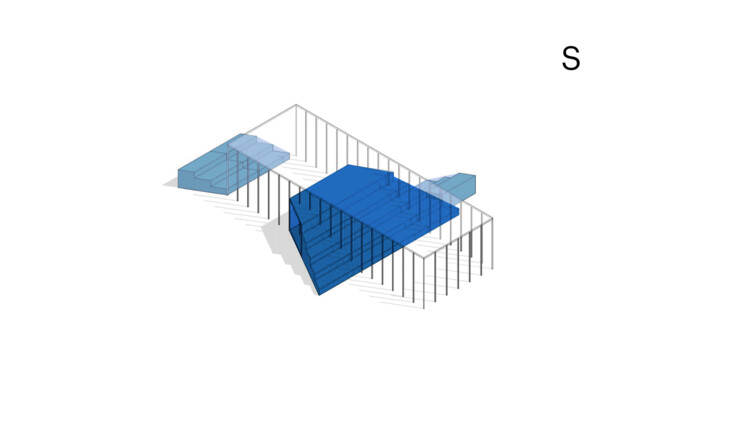
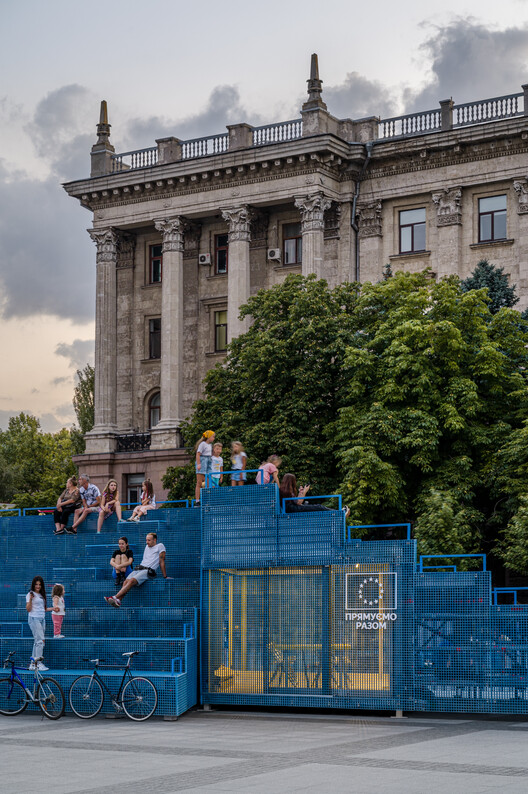
Operating on dual scales, the Mobile Pavilion promotes cultural integration with the EU while decentralizing culture within Ukrainian cities. In the country, there has been a tendency to concentrate efforts on cultural developments within the capital city and large metropolises. The Mobile Pavilion brings a paradigm shift where funds and programs are allowed to penetrate smaller towns of Ukraine. The design aims to be an interactive public space, letting users engage with the system irrespective of the House of Europe’s programs. This flexibility transforms the Pavilion into a dynamic platform for community interaction.
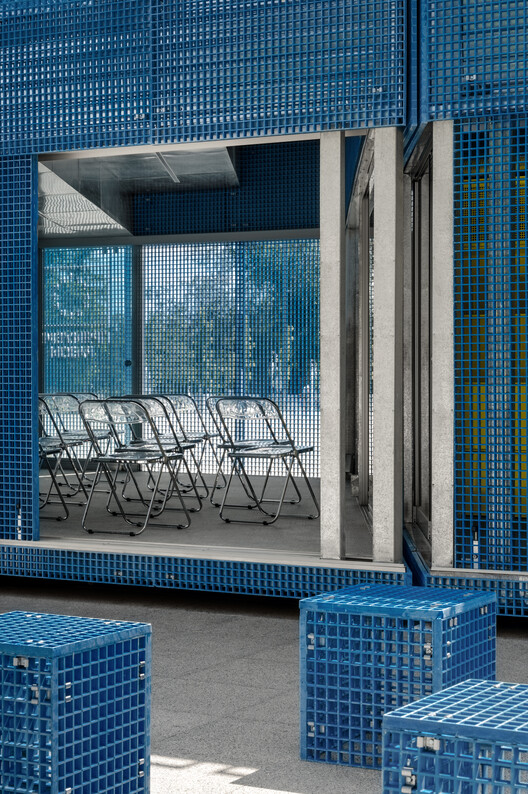
prototype envisions a new era for Ukraine, one defined by responsible contextual design and infrastructural growth. “After the victory, Ukraine would become a great construction site in the world, gathering interest from international and local architects”, Buchatska believes, “It is important that architects deeply understand and respect the historical layers that define the landscape of Ukraine”. This new era empowers local architects to take ownership of their spaces, catalyzing recovery through activism and innovative design. The trajectory of Ukrainian architecture is set to flourish, with local architects driving progress and transformation.
prototype’s impact transcends architectural innovation; it extends to the transformation of public spaces, cultural integration, and Ukraine’s resurgence on the global stage. Through their Mobile Pavilion and other groundbreaking projects, prototype shapes not only buildings but also experiences, fostering connections between people, contexts, and ideas.
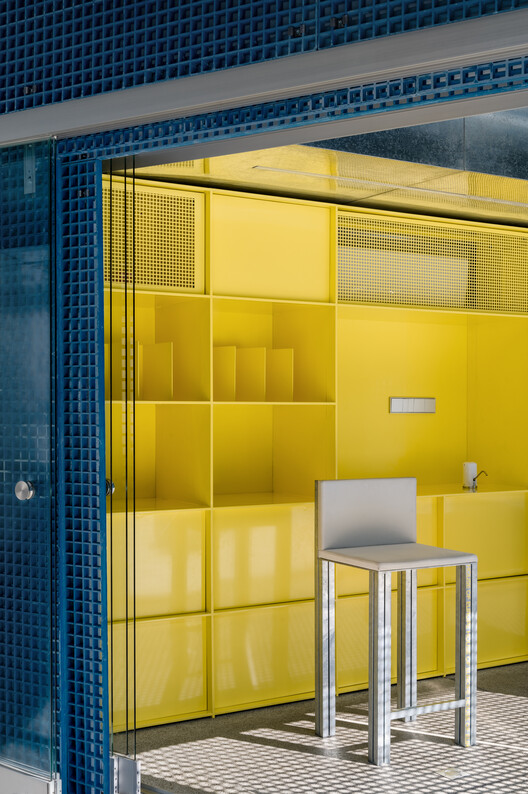
This feature is part of an ArchDaily series titled AD Narratives where we share the story behind a selected project, diving into its particularities. Every month, we explore new constructions from around the world, highlighting their story and how they came to be. We also talk to the architect, builders, and community seeking to underline their personal experience. As always, at ArchDaily, we highly appreciate the input of our readers. If you think we should feature a certain project, please submit your suggestions.

